Nuns on the Run: An unconventional game of stealth (in a convent)
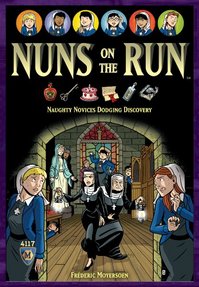
If you set out to make a board game out of the best elements of capture the flag, hide and seek and the sneaking elements of Metal Gear Solid, you would come up with Nuns on the Run. In this game, one player plays two head nuns, while all of the other players play novices looking to sneak around the church and back to their rooms without being seen.
This makes for quite a game experience. Because all of the information is hidden, novices will have the excitement of watching the head nuns move right past their position where they might be hiding around the corner. Hidden information also means that everyone has to have a good grasp of the rules or they’ll give themselves away. Let’s take a look at the game play so that we can see if this game will make you vow to play again or if you'd rather donate it to The Salvation Army.

The Abbess makes her way through the chapel, no novices in sight.
Mike Hulsebus | Contributor
Rules Summary
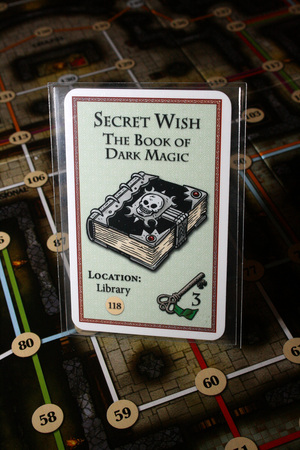
A secret wish card details what item a novice will need in order to win.
Mike Hulsebus | Contributor
All novice players start the game by getting a secret wish card that determines what they need to get (whether it be a letter from home or a spell book of dark magic). To win, that novice will need to get a set of keys, get their item, and sneak back to their cell without getting nabbed by the head nuns.
The person running the head nuns — the Abbess and the Prioress — is the only player whose movement is shown on the board. On his first turns, the player playing the abbess and prioress will choose what routes they will be taking. This information is known to the novices, who will have to try to plan their path to victory so that it takes them as far away as possible from their pursuers.
Each turn, a novice has to decide whether she wants to move quickly and potentially make a lot of noise, or whether she wants to move slowly and make less noise. After all the novices move, they each roll a die, and if they are within that many spaces (minus their modifier for movement speed), they must let the abbess and prioress know that they heard a noise and which direction the noise came from. To show this, they place a noise token on the board in that direction. Then, the head nun that heard them is able to deviate from her path and run in any direction, hoping to either see the nun or at least be close enough that she will hear her again next turn.
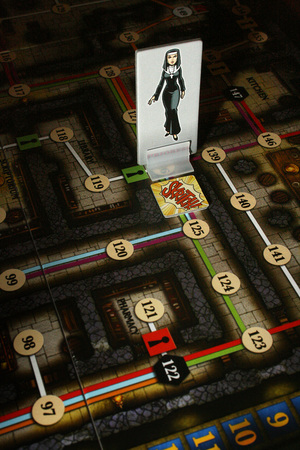
The noise token in front of the Prioress tells her only the direction the noise was in: should she turn down the first hall or the second?
Mike Hulsebus | Contributor
Even if seen, all hope isn’t lost for the novices. They can run away, trying to duck around corners before the nun can move onto their space, capturing them. If they can get out of sight and not be heard, the head nuns are forced to returned to their chosen routes. A captured nun loses her secret wish if she has it and has to walk toward her cell (until she’s out of sight and can run off again toward her goal).
The head nuns win if they capture novices a number of times equal to the total number of players or if too many turns elapse. A novice wins if she if the first to get her secret wish and return to her cell.
Things to consider
While I really enjoy this game, I want to caution you about a few things before you consider buying it. Most importantly, you need to realize that if you buy this game, you have to know that everyone else’s enjoyment of the game is going to be based on how well you know the rules and how well you explain them.
All movement by the novices is handled by writing down which spaces on the board you moved to on a secret pad of paper: you location has to be secret, so there aren’t any pieces on the board unless you’re spotted. This means you can’t really ask questions. If the abbess moves and someone asks, “Can abbesses hear through doors?” they’ve just told the abbess that they’re hiding in the room behind that door. Players have to have a good handle on the rules before they start, otherwise they could lose, accidentally cheat or feel like they’re stuck in a game the don’t understand just because they couldn’t ask a question to check something.
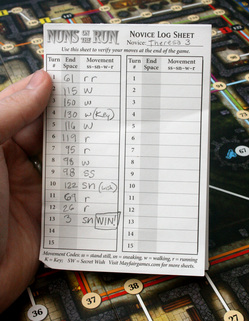
Players being novices keep track of their locations in logs rather than on the board.
Mike Hulsebus | Contributor
You can help out somewhat by counting out the spaces: “Ok, so my abbess can hear you if you’re four spaces away. So if you’re here, here, here or here, put a noise token down,” for example. But once the abbess steps into the cathedral, line of sight affects what spaces she is able to see. So you have to know which walls block sight and which ones don’t and how far you can see into the room. Novices can’t consult charts because nothing says “you’re getting close to me” like a long pause after the question, “Can I see anyone in the room?”
The only other thing to consider about what hidden information does to a game is that there will be a point in the game where suddenly a novice will say “I win” and the game is over. Other players might not have a clue that the game was about to end and may have thought they were slowly strolling to victory. As for me, I don’t mind this because, after the game is done, it’s still fun to use the movement logs to go back and reconstruct the game and see who went where and when. But be prepared for the fact that there comes a point where a player could suddenly win.
Overall Thoughts
Despite what the previous three paragraphs might make you think, Nuns on the Run is decently easy for players to pick up from an explanation. The first-game rules explanation takes probably 15 minutes, and the game itself about 45 minutes after that. A lot of other board game reviewers have talked about how this is a favorite game to play with their family (the box recommends the game for ages 10+), but, if they can get past the cartoony illustrations and nun theme, I primarily think of this as a good gamer’s game.
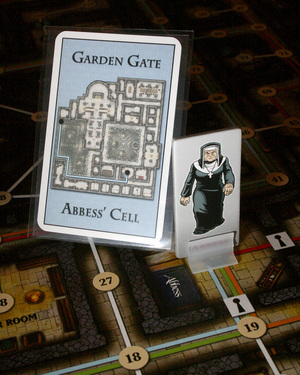
It may be open information which way the Abbess is going, but if she hears a noise, she is allowed to deviate from her path to chase after the novices.
Mike Hulsebus | Contributor
The board is great and clearly a lot of thought went into it. There are a lot of good hiding places for the nuns like the confessional booths. In the confessionals, the player can only be seen someone in directly on their space — so you can watch the nuns hear you make a noise, assume it came from outside and run right by you. There are also a good number of choke points and bottlenecks for the head nuns to use. Keep in mind that they only need to catch nuns a number of times equal to the number of players: they don’t need to catch each nun one time. They don’t know who is going for what, but they do know where the keys are around the place and can take paths that hopefully with run them right into a group of nuns, allowing them to run through and capture them.
When you’re thehead nuns, it’s fun to feel like you’re right on someone’s heels and to turn the corner and find them. When you’re the novices, it’s fun watch the nuns think they are getting close to you, only to watch them run to the opposite side of the board.
I own no other games like this and can think of no other games out there that have the same feel as this game (well, except Fury of Dracula to some extent, but that’s many players searching for one player, involves combat, and I don’t own it). So if you’re looking for a game in which players have to use stealth and a little luck to succeed, Nuns on the Run is it.
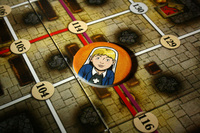
Mike Hulsebus | Contributor
Well explained and run well, Nuns on the Run is a game that offers an exciting play experience for everyone involved — and how often can you say that about a game? Just because a game is good doesn’t mean that game has excitement to it. Nuns on the Run is by no means a perfect game, but it’s certainly fun and exciting. For me, that’s what’s important and what makes Nuns on the Run great.
Mike Hulsebus disguises himself as a cardboard box when he needs to evade capture. If his box has wi-fi access, he can be reached at mikehulsebus@gmail.com


Comments
Rob T
Mon, Jan 17, 2011 : 11:37 a.m.
I played Mr X once a few years ago, sort of the opposite: everyone searches for one hidden player. A highlight is that it comes with a visor for the hidden player so that no one can see where she's looking.